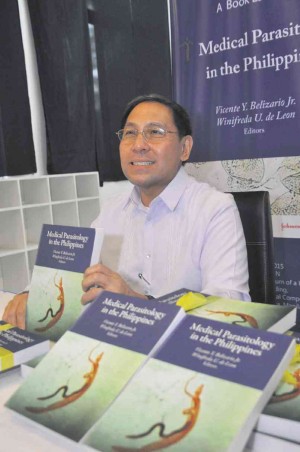Updated book on parasites
PARASITES have been known to wreak havoc in the human body since prehistoric times. Throughout the ages, we have actively fought against them, particularly those that attack our intestines. But as focus shifted to other health issues, it gave us the notion that the fight against these hardy creatures had been won. However, the disease incidence data indicate otherwise.
According to the World Health Organization, approximately two billion people are infected with soil-transmitted helminths—parasitic worms—worldwide. Infected children are impaired physically, nutritionally and cognitively.
Here in the country, four out of 10 Filipino children are infected with intestinal worms and 67 percent of all school-age children have soil-transmitted intestinal parasitism, according to the Department of Health.
Third edition
This high incidence of parasitism prompted the University of the Philippines Press to launch the third edition of “Medical Parasitology in the Philippines,” a best-selling book edited by Health Undersecretary Dr. Vicente Belizario Jr. and fellow UP Manila College of Public Health professor, Dr. Winifredo de Leon.
Article continues after this advertisementThe book was first published in 1998 and has since sold 16,470 copies.
Article continues after this advertisementBelizario said the book aims to serve as an invaluable tool for students of medicine, public health, medical technology and nursing, as well as postgraduate students of public health, residents and fellows. It may also be used as a training material of the health department.
“Parasitic infections remain as a major challenge to public health, especially in developing countries like the Philippines despite significant advances in terms of better understanding of the epidemiology of these infections, improved diagnostic tools and newer approaches to control. The development of this learning resource is a response to these continuing challenges,” he added.
During the launch, UP Manila Chancellor Manuel Agulto said the overwhelming response to the first two editions of the book affirmed the value and significance of the material in complementing meager publications on medical parasites with special focus on the local setting. “I am confident that this latest edition of the book will serve as an accurate and valuable reference material in the continuing war against parasites,” said Agulto.
Grant
The publication of the third edition was made possible by a grant from Johnson & Johnson (Philippines) Inc., which also supported the development of the first two editions of the book.
“This undertaking is aligned with our strategic mission to make life-changing, long-term differences in human health,” said Sean Zantua, JJPI human resource and contributions director.
He added that by supporting efforts such as this medical parasitology book, Johnson & Johnson demonstrated how business, governments and health providers can unite to address our most serious health issues and improve quality of life for people in the country.
The third edition of “Medical Parasitology in the Philippines” contains updated global, regional and national status of parasitic diseases, with particular focus on the Philippines. It also includes new sections on recent developments in the field and other topics relevant to the country such as neglected tropical diseases, preventive chemotherapy, emporiatrics and laboratory biosafety.
For the first time, relevant policies and guidelines from the DOH are listed for the guidance of the readers.
Belizario hopes that with the launch of the book, parasitic infections in the country would be better understood, diagnosed, treated, controlled and prevented for a healthier and more productive populace.
